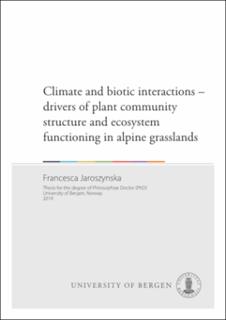| dc.contributor.author | Jaroszynska, Francesca | |
| dc.date.accessioned | 2020-02-11T09:16:38Z | |
| dc.date.available | 2020-02-11T09:16:38Z | |
| dc.date.issued | 2019-10-21 | |
| dc.date.submitted | 2019-10-02T12:42:30.283Z | |
| dc.identifier | container/09/78/7f/87/09787f87-9549-4050-818b-7845a8644b1c | |
| dc.identifier.uri | http://hdl.handle.net/1956/21382 | |
| dc.description.abstract | The governing of biodiversity by climate is profound. Climate as reflected through the major global temperature and precipitation axes determines the distribution of species according to their climatic tolerance, or niche. Interactions among species can mediate strong climate boundaries by expanding the margins of their realised niche through the outcome of positive and negative interactions with other species. However, global climate is undergoing rapid change, not only through increased temperatures and a redistribution of rainfall patterns, but also through a higher frequency of extreme weather events. These ongoing changes have led to a global redistribution of species, the rate of which is most pronounced in alpine regions. The variation in species-specific responses to climate change, according to their climate niche and function in the ecosystem, has consequences for community assembly and the ecosystem’s functioning in alpine regions. However, very little is hitherto known about how biotic interactions mediate the combined effects of temperature and precipitation on ecosystem functioning, plant community functioning, and recruitment. I address these unresolved questions by monitoring biotic and abiotic responses to a fully factorial removal experiment of functionally different plant types – graminoids, bryophytes and forbs – in semi-natural alpine grasslands, replicated along natural climate gradients in southern Norway. I found that although ecosystem functioning and community dynamics were largely determined directly by temperature and precipitation, these effects were strongly mediated by functional group interactions. In particular, bryophytes played a critical role – their facilitative presence increased carbon uptake by forbs at colder alpine sites, whilst limiting carbon uptake by graminoids at warmer boreal sites. Similarly, the strength of soil microclimate regulation was greatest by bryophytes, reducing both growing-season soil temperature on days with high incoming solar radiation, and reducing soil freezing during autumn and winter. Bryophyte presence additionally promoted seedling recruitment by forbs under drought conditions. Finally, graminoids alleviated climate severity for forbs in cold climates but heightened competition for resources in warm and wet climates, resulting in a selection for forb species with competitive trait attributes. The result of this effect is an inevitable reduction in biodiversity of these highly diverse ecosystems. Further increases in temperature and precipitation will increase graminoid dominance, at the expense of forb functioning and cover. More generally, and consistently across all components of ecosystem functioning addressed in this thesis, the interactive effects of temperature and precipitation point towards non-linear changes in biotic interactions under climate change. Not only was ecosystem functioning regulated by long-term climate at the landscape scale, but also by interannual climate variation and the occurrence of extreme weather events. By conducting macroecological experiments over several years we can conclude that the spatio-temporal variation in climate causes substantial fluctuations in the role of biotic interactions in regulating carbon fluxes, microclimate, and recruitment. In this thesis I demonstrate that the outcome of biotic interactions is dependent on regional climate, with important consequences for community structure and functioning in semi-natural grasslands. As temperatures and precipitation levels increase, alpine grasslands will become more carbon-rich and with more stable and homogeneous microclimates, whilst simultaneously becoming increasingly species poor and asymmetrical. This loss of biodiversity and change in ecosystem functioning has large consequences not only for species distributions and the persistence of alpine plants, but also more widely for predictions of ecosystem responses to further climate change. | en_US |
| dc.language.iso | eng | eng |
| dc.publisher | The University of Bergen | en_US |
| dc.relation.haspart | Paper I: Jaroszynska, F., Olsen, S. L., Gya, R., Klanderud, K., Telford, R. J., and Vandvik, V. Functional trait responses reveal decreasing intensity of whole community competitive interactions towards colder and drier climates. The article is not available in BORA. | en_US |
| dc.relation.haspart | Paper II: Althuizen, I. H. J., Jaroszynska, F., Halbritter, A. H., Lee, H., Olsen, S. L., Vandvik, V. The effect and compensation capacity of plant functional groups on ecosystem carbon exchange in alpine grasslands under climate change. The article is not available in BORA. | en_US |
| dc.relation.haspart | Paper III: Jaroszynska, F., Althuizen, I. H. J., Halbritter, A. H., Telford, R. J., Lee, H., Klanderud, K., Vandvik, V. Plant functional groups regulate soil microclimate in alpine grasslands. The article is not available in BORA. | en_US |
| dc.relation.haspart | Paper IV: Jaroszynska, F., Olsen, S. L., Klanderud, K., Vandvik. V. Functional groups differentially regulate the effect of drought on forb seedling recruitment in alpine grasslands. The article is not available in BORA. | en_US |
| dc.rights | In copyright | eng |
| dc.rights.uri | http://rightsstatements.org/page/InC/1.0/ | eng |
| dc.title | Climate and biotic interactions – drivers of plant community structure and ecosystem functioning in alpine grasslands | en_US |
| dc.type | Doctoral thesis | |
| dc.date.updated | 2019-10-02T12:42:30.283Z | |
| dc.rights.holder | Copyright the Author. All rights reserved | en_US |
| dc.contributor.orcid | https://orcid.org/0000-0002-2399-4146 | |
| dc.identifier.cristin | 1738472 | |
| fs.unitcode | 12-60-0 | |
